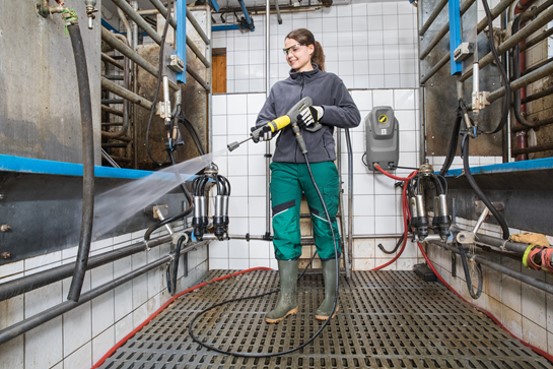Cleaning and Hygiene in Dairy Farming
As an essential part of biosecurity in dairy farming, hygiene is becoming increasingly important for cows and calves. The correct cleaning processes play a special role around the birth and rearing of sensitive calves, as well as the feed supply and in the milking parlour. Here you will find an overview of which aspects are particularly important and which cleaning technology is best suited to the task.
Cleanliness in Calf Rearing
Like all young animals, new-born calves are very delicate and must be protected from all kinds of germs. To ensure this, the calving pen should be cleaned with a high-pressure cleaner using hot water for every calving cow. A measurable reduction in germs can be achieved with thorough work and a water temperature of at least 85 °C. Disinfection is recommended afterwards. Evidence from research shows that these measures are worthwhile: The first weeks after birth have an influence on the future dairy cows' milk and life performance.
When the calf finally moves from the individual pen into group housing, the new environment is an initial challenge for the immune system. This is the case particularly where the calves come from different holdings. Hygiene plays an important role in minimising germ pressure. Before the calves move in, the shed must be thoroughly cleaned with hot water and disinfectant. In order to remove dirt and residual water, a wet and dry vacuum cleaner can effectively support the high-pressure cleaner's work. In addition to the entire cowshed, the water supply and the tools used, such as a broom or shovel, must not be forgotten during cleaning. Introducing foreign matter from the environment into the cowshed can be reduced by the regular use of a sweeper.
Clean Feed Supports the Immune System
The animals' immune system and health are supported by a stable intestinal flora. In order to supply the animals with clean fermented feed and lactic acid bacteria, which are very important for the intestinal flora, cleaning the silos before storing the silage is absolutely vital. Coarse dirt can first be removed with a sweeper. Using a high-pressure cleaner is recommended afterwards. If grain and other ingredients such as protein or mineral feed come out of storage, all sources of contamination must be eliminated during processing. Only thorough work can prevent rodents, other pests, mould and mycotoxins from endangering animal health. Therefore, dust and impurities have to be regularly removed not only in the silos, but also at the gristmill and at the feed mixer. Wet and dry vacuum cleaners as well as sweepers or vacuum sweepers are very well suited for this work.
Particular attention is paid to outdoor silos, whose contents are exposed to daily temperature fluctuations and thus to the formation of condensation water. A check before each filling and at least one annual deep cleaning with a high-pressure cleaner and hot water should be performed as standard. Regularly cleaning the farmyard surface of feed residue and dirt with a sweeper also removes potential food sources for rodents in outside areas, which further increases biosecurity.
High Pressure Cleaning in the Milking Parlour
The milking parlour is the delicate part of the dairy cowshed where animal husbandry and food meet. Hygiene is twice as important. To prevent germs from spreading from one animal to the next, the milking parlour must be cleaned with a high-pressure cleaner after each milking. Additional suitable cleaning agents should be applied with a foam lance several times a week in order to interrupt infection chains and remove all residues. One advantage of cleaning foam is that it is so stable that it sticks to surfaces and increases contact time and cleaning power. The water used for rinsing should be of high quality in order to prevent further germination. If the ground does not dry by itself before the next milking, a wet and dry vacuum cleaner helps to ensure a dry and non-slip ground.
For the separate milk store, the same conditions apply as for the milking parlour itself. High-pressure cleaners and hot water, as well as cleaning agents, ensure that dirt is removed as comprehensively as possible. In this case, wet and dry vacuum cleaners can also be used to prevent mould forming from any remaining moisture and to prevent the risk of slipping.
A Trio of Machines Covers All Cleaning Requirements
One thing quickly becomes clear, basic equipment consisting of a high-pressure cleaner, sweeper and wet and dry vacuum cleaner can be used flexibly, and comprehensively covers nearly all cleaning requirements. This ensures that all hygiene measures meet biosecurity requirements and thus promote the health and wellbeing of cows and calves. In order for cows to be able to perform well in life and for high biosecurity to be guaranteed on the farm, the environment must be hygienically clean from the calf's birth. Individual hutches should be cleaned with high pressure washers, hot water and a suitable cleaning agent. Disinfection is recommended afterwards. The cowshed's surroundings can be cleaned of dust and dirt with a sweeper. A high-pressure cleaner in combination with hot water is often sufficient for cleaning tasks. If required, a foam lance and cleaning agent can also be used – this increases the contact time. A wet and dry vacuum cleaner can be used in the milk store to prevent mould forming due to moisture.

Secure Tools supplies an extensive collection of Karcher cleaning machines - including high-pressure cleaners, sweepers and wet and dry vacuum cleaners. View the range here.
To discuss your requirements for cleaning farm areas, call the Secure Tools Team on 01274 308961.
‹ Go Back